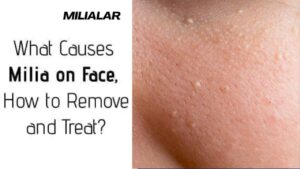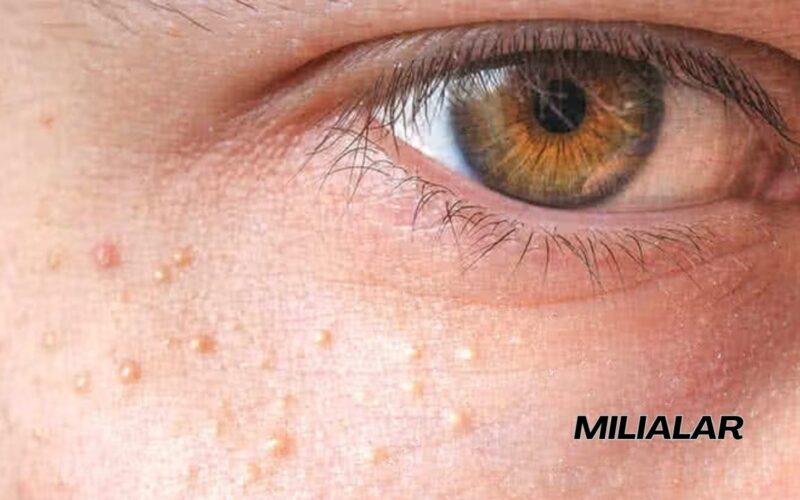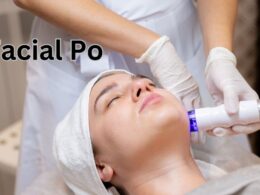Usually found on the face, milia are tiny white pimples on the skin’s surface. These small cysts are often puzzling since they appear suddenly. What are Milialar, what causes them, how they can be treated, and more will all be covered in this article. Let us therefore, as a group, attempt to solve the milia puzzle.
What Are Milialar?
Definition of Milialar
Milk spots (milia) are small, dome-shaped cysts that develop just below the skin’s surface. These cysts can appear anywhere on the body, though the face is particularly prone to them. They are often white or yellow in color.
Types of Milialar
There are two primary types of milia:
Primary Milia
The accumulation of dead skin cells just below the skin’s surface causes primary milia, which appear on the skin of infants.. As the baby’s skin develops, these tiny cysts usually go away on their own.
Secondary Milia
However, adults are more likely to get secondary milia. Damage to the skin, burns, or prolonged exposure to sunlight are all potential causes.
What Causes Milialar?
Causes of Milia
Keratin is a skin protein that becomes stuck under the epidermis, giving rise to milia. This can be caused by a number of different things:

Skin Damage
Milia can flourish in areas of damaged skin such as blisters, burns, or sunburns.
Use of Heavy Cosmetics
Using cosmetics or skincare products that are too thick or comedogenic can cause miliaria, which means they block pores.
Genetics
Milia can develop at an early age in some people because of their genetic makeup.
Identifying Milialar
Milia are commonly recognized insects. They manifest as discrete, slightly elevated pimples on the skin. White or yellow in color, these cysts do not cause any sort of irritation to the skin. People frequently misidentify milia as whiteheads, despite the fact that they do not produce pus.
Can You Prevent Milialar?
Preventing Milia
Although there is no surefire method of preventing milia, you can lessen your chances by taking the following measures:
Gentle Exfoliation
Regular, mild exfoliation can help avoid the accumulation of dead skin cells, which can cause milia..
Non-Comedogenic Products
To avoid blocked pores, use only skincare and makeup that has been specifically labelled as non-comedogenic.
Treating Milialar
You may be asking what to do about your milia if you already have them. The severity and location of the milia will determine the best course of treatment.
Home Remedies
Warm Compress
Opening the pores and draining spontaneously can help with milia by applying a warm, damp towel to the affected area.
Gentle Exfoliation
Mild exfoliation using a scrub can aid in the removal of dead skin cells and speed up the healing process for milia.
Professional Treatment
Extraction
Milia can be safely extracted by a dermatologist using a sterile needle or lancet.
Chemical Peels
Milia can be eliminated with the help of a chemical peel, which eliminates the top layer of skin.
Conclusion
Milia, in conclusion, are superficial, benign cysts that typically manifest on the face. Although they can be a nuisance, there are a number of remedies available for dealing with them, both at home and through medical specialists. Sticking to a gentle skincare routine and staying away from pore-clogging products can help avoid milia.
Frequently Asked Questions
Q1. Are milia a type of acne?
Miliaria are not the same thing as acne. These white pimples do not share the same bacteria or pus that cause acne, although they have the same visual characteristics.
Q2. Do milia go away on their own?
Babies frequently outgrow their primary milia as their skin develops. Adults, however, may need medical intervention to get rid of them.
Q3. Are there any long-term health risks associated with milia?
In most cases, milia are completely safe and offer no health hazards at all. They mostly affect the way you look..
Q4. Can I use over-the-counter products to treat milia?
The best course of action for treating milia, especially if they continue despite treatment with over-the-counter medicines, is to see a dermatologist.
Q5. Can milia be a sign of an underlying skin condition?
Miliaria are harmless bumps that can appear on the skin due to factors like skin damage, excessive sun exposure, or the use of pore-clogging therapies.. See a dermatologist for an examination if your skin is causing you concern.








